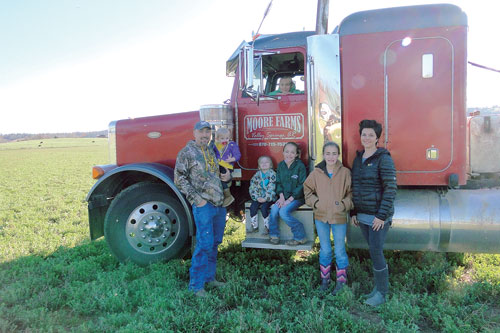
Jack and Tammy Simmons own and lease over 1,000 acres outside of Stilwell, Okla., on which they run a cow/calf operation and a brand new four-house Tyson chicken farm.
Currently the Simmons’ have 230 momma cows and 10 Charolais bulls. Jack explained that the commercial cattle operation began with Beefmaster bulls because he believes they cross better with F1s and Tiger Stripes and Angus cows producing calves with better frame and growth rate which, in turn, produces more pounds at weaning.
Jack works the calves when they are babies – castrating, vaccinating and deworming. He usually sells the calves right at weaning though he will wait if the market isn’t good enough. At sale time the calves weigh 500 to 700 pounds and are usually sold at the Joplin Regional Stockyards where his brother is a field representative. Jack said, “I’ve always been treated well there and they charge a flat fee commission, which I prefer.”
Jack’s current goal is not to increase the size of the herd but improve genetics through culling and buying high-quality bulls and cows to supplement replacement heifers.
Jack explained that the biggest challenge for him as well as most farmers is the weather. When the weather is dry and in the fall Jack supplements with liquid feed. Jack also hays 150 acres of bermuda/fescue containing naturally occurring clovers and a 20-acre alfalfa field for higher protein hay. Jack said, “I keep alfalfa hay for bad weather or early spring before the grass is mature enough because cows chase the green grass and then have intestinal stress.” Fields are fertilized with 32 percent liquid fertilizer at the end of April or first of May. He sprays in the spring for weeds, sometimes at the same time as the fertilizer. Occasionally, he will spot spray for thistles and for brush control in late summer.
Not long ago Tammy had the opportunity to choose between having an off-the-farm job or working on the farm. Coming from a family of chicken growers in California, she opted to stay at home and raise chickens knowing what she was getting into. The couple built four houses and is on their fourth flock of broilers. The computer system is elaborate with alarms for low water pressure, maximum feed time, feed bin control, air pressure and vent control for fresh air and temperature control which adjusts to the birds age.
Tyson prefers an average weight of 6.25 to 6.50 pounds. The Simmons’ had an above average weight with their first flock averaging 7.75 pounds because pickup was put off for two days and because the houses had new bedding and equipment. Advantage of their farm’s location is that it is isolated from other chicken farms providing a huge health advantage for their chickens. Tammy said, “We keep the birds for 49 days with the first and last weeks being the most difficult.” The first week is time-consuming because of equipment adjustment while the last is difficult because the birds are so large and difficult to walk through.
Currently, dead chickens are incinerated but the couple is building a stacking shed which layers litter and dead chickens. They prefer to use dried shavings for bedding and have bait traps outside to support the bug spraying before every flock arrives.
The 13 to 14 days between litters are busy ones. When the chickens are mature, a six-man crew, who take 5 to 6 hours per house, catches them by hand. Then the litter is windrowed into three rows which sit for three days before being turned over to sit for another three or four days. Next the litter is re-spread and large litter clumps removed. Finally, the houses are set up for baby chicks.
The couple admits that their goal is to get out of debt so Jack can purchase windrowing and de-caking equipment. Jack says, “We want to be more independent and more equipment will help us get there.”
Jack is also active in the community serving on the Adair Farm Bureau, Adair Fair and Christie Community boards as well as being a member of the Texas and Southwestern Cattle Raisers Associations.







